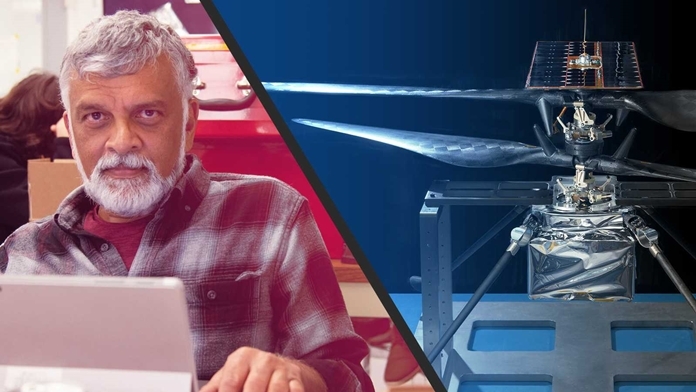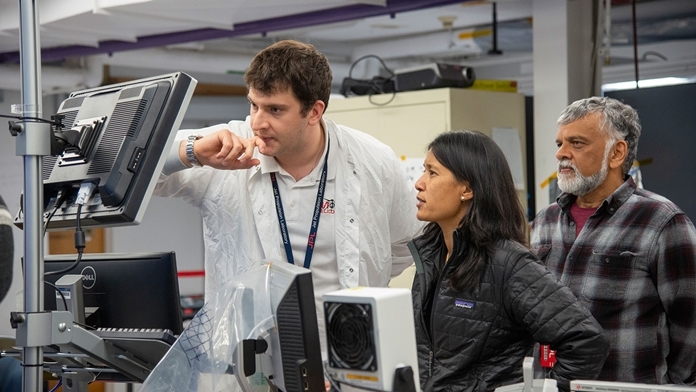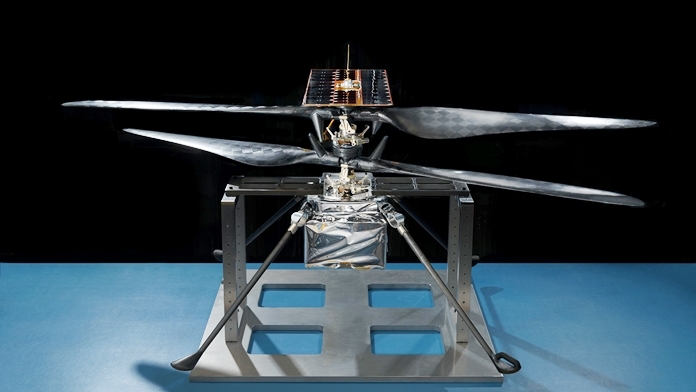
Even before this interviewer can finish the question, “Did anyone ever tell you this was a crazy idea?” Bob Balaram jumps in: “Everyone. All the time.”
This “crazy idea” is the Mars Helicopter, currently at Kennedy Space Center waiting to hitch a ride to the Red Planet on the Mars Perseverance rover this summer.
Although Balaram probably didn’t know it at the time, the seed for an idea like this sprouted for him in the 1960s Apollo era, during his childhood in south India. His uncle wrote to the U.S. Consulate, asking for information about NASA and space exploration. The bulging envelope they sent back, stuffed with glossy booklets, entranced young Bob. His interest in space was piqued further by listening to the Moon landing on the radio. “I gobbled it up,” he says. “Long before the internet, the U.S. had good outreach. You had my eyeballs.”
His active brain and fertile imagination focused on getting an education, which would lead him to a bachelor’s degree in mechanical engineering from the Indian Institute of Technology, a master’s and Ph.D. in computer and systems engineering from Rensselaer Polytechnic Institute, and a career at NASA’s Jet Propulsion Laboratory in Southern California. That’s where he has remained for 35 years as a robotics technologist.
Balaram’s career has encompassed robotic arms, early Mars rovers, technology for a notional balloon mission to explore Venus and a stint as lead for the Mars Science Laboratory entry, descent and landing simulation software.
Cutting through obstacles, red tape and the Martian atmosphere
As with many innovative ideas, it took a village to make the helicopter happen. In the 1990s, Balaram attended a professional conference where Stanford professor Ilan Kroo spoke about a “mesicopter,” a miniature airborne vehicle for Earth applications that was funded as a NASA Innovative Advanced Concepts proposal.

This led Balaram to think about using one on Mars. He suggested a joint proposal with Stanford for a NASA Research Announcement submission and recruited AeroVironment, a small company in Simi Valley, California. The proposal got favorable reviews, and although it was not selected for funding at that time, it did yield a blade-rotor test under Mars conditions at JPL. Other than that, the idea “sat on a shelf” for 15 years.
Fast forward to a conference where the University of Pennsylvania presented about the use of drones and helicopters. Charles Elachi, then director of JPL, attended that session. When he returned to JPL, he asked whether something like this could be used on Mars. A colleague of Balaram’s mentioned his previous work in that area of research. Balaram dusted off that proposal, and Elachi asked him to write a new one for the competitive call for Mars 2020 investigation payloads. This sped up the process of developing a concept.
Balaram and his team had eight weeks to submit a proposal. Working day and night, they met the deadline with two weeks to spare.
Although the helicopter idea was not selected as an instrument, it was funded for technology development and risk reduction. Mimi Aung became Mars Helicopter project manager, and after the team worked on risk reduction, NASA decided to fund the helicopter for flight as a technology demonstration.
Building and testing a beast
So then the reality set in: How does one actually build a helicopter to fly on Mars and get it to work?
No easy feat. Balaram describes it as a perfectly blank canvas, but with restrictions. His physics background helped him envision flying on Mars, a planet with an atmosphere that is only 1% as dense as Earth’s. He compares it to flying on Earth at a 100,000-foot (30,500-meter) altitude — about seven times higher than a typical terrestrial helicopter can fly. Another challenge was that the copter could carry only a few kilograms, including the weight of batteries and a radio for communications. “You can’t just throw mass at it, because it needed to fly,” he says.
It dawned on Balaram that it was like building a new kind of aircraft that just happens to be a spacecraft. And because it is a “passenger” on a flagship mission, he says, “we have to guarantee 100% that it will be safe.”

The end result: a 4-pound (1.8-kilogram) helicopter with two pairs of light counter-rotating blades — an upper and lower pair, to slice through the Martian atmosphere. Each pair of blades spans 4 feet (1.2 meters) in diameter.
Once it was built, Balaram says, the question was, “How do you test this beast? There’s no book saying how.” Because there is no easily accessible place on Earth with a thin atmosphere like the one on Mars, they ran tests in a vacuum chamber and the 25-foot Space Simulation Chamber at JPL.
About two-and-a-half months after landing at Jezero Crater, the Mars Helicopter team will have a window of about 30 days to perform a technology demonstration in the actual environment of the planet, starting with a series of vehicle checkouts, followed by attempts of first-ever flights in the very thin Martian atmosphere.
Despite best efforts and the best tests available on Earth, this is a high-risk, high-reward technology demonstration, with Balaram saying quite frankly, “We could fail.”
But if this “crazy idea” succeeds on Mars, it will be what Balaram describes as “kind of a Wright Brothers moment on another planet” — the first time a powered aircraft will have flown on Mars, or any planet besides Earth, for that matter. This potential breakthrough could help pave the way for future craft that would expand NASA’s portfolio of vehicles to explore other worlds.
And partly because there have been so many challenges along the way, it’s a testament to the dedication, vision, persistence and attitude of Balaram and his colleagues that the Mars Helicopter concept was funded, planned, developed and built and is heading to the Red Planet this summer.
“Bob is the inventor of our Mars Helicopter. He innovated the design and followed up on that vision to its fruition as chief engineer through all phases of design, development and test,” says project manager Aung. “Whenever we encountered a technical roadblock — and we encountered many roadblocks — we always turned to Bob, who always carries an inexhaustible set of potential solutions to be considered. Come to think of it, I don’t think I have ever seen Bob feeling stuck at any point!”
The home stretch toward Mars
The main purpose of the Mars 2020 mission is to deliver the Perseverance rover, which will not only continue to explore the past habitability of the planet, but will actually search for signs of ancient microbial life. It will also cache rock and soil samples for pickup by a potential future mission and help pave the way for future human exploration of Mars. Even if the helicopter encounters difficulties, the science-gathering mission of the Perseverance rover won’t be affected.
Balaram points out that in addition to the usual “seven minutes of terror” experienced by the team on Earth during a Mars landing, once the helicopter is on Mars and attempting to fly, “This is the seven seconds of terror every time we take off or land.”
Does Balaram worry about all this, even a little? “There’s been a crisis every single week of the last six years,” he says. “I’m used to it.”
Balaram sheds any stress that may crop up through backpacking, hiking and massage. There’s also his very supportive wife, Sandy, who bears a title within the team and her own acronym: CMO, or Chief Morale Officer. She has regularly baked cakes, pies and other goodies for Balaram to share with his colleagues for sustenance during the long process.
And he has high praise for his teammates on the Mars Helicopter project, saying the people attracted to it are agile and fast-moving. “It’s a great team, determined to dare mighty things — that’s the fun part,” Balaram says. His take on daring mighty things: “Good ideas don’t die — they just take a while.”
 |
 |
 |





